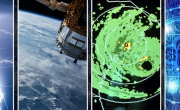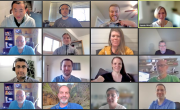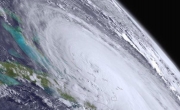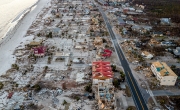Winter 2022 | Traditional radar product integrity suffers from gaps in coverage over large areas. While some geographical areas are fortunate to have ground- and/or satellite-based radar coverage, most areas around the globe do not have complete coverage from reliable radar networks. The use of radar-based products is advantageous for understanding current weather conditions and how weather systems may evolve over time. Convection and precipitating weather systems often… Read More
Bridges to Operations: A Comprehensive Retrospective Evaluation of the Global Synthetic Weather Radar Products Using METplus

Visitors: Physics Process-based Evaluation of the Hurricane Vortex Structure and Size of Tropical Cyclones in HAFS
Visitor: Shaowu Bao

Winter 2022 | The Hurricane WRF (HWRF) has been the US operational hurricane forecast model since 2007. The Hurricane Forecast and Analysis System (HAFS), based on the GFDL Finite-Volume Cubed-Sphere Dynamical Core (FV3), a scalable and flexible dynamical core, is the likely candidate to replace the operational HWRF. HAFS is the focus of a Unified Forecast System - Research to Operations (UFS-R2O) hurricane modeling project and the next generation hurricane forecast system.… Read More
Community Connections: UFS SRW Application Training: The Wrap Up

Winter 2022 | Supporting the development of the Unified Forecast System (UFS) has been a central focus of the DTC for several years now. Many staff have concentrated on support, development, and training of this new state-of-the-art system that bridges the gap between the research and operational communities. In September 2021, we… Read More
Did you know?: DTC Visitor Program accepting applications
Winter 2022 | Despite the challenges of COVID, the DTC Visitor Program is thriving. With the incremental opening of NCAR facilities, some visitors have been working on site, while others have been collaborating with DTC staff remotely. We invite researchers to apply to the program as an opportunity to collaborate with us on a diverse range of exciting projects. Our program has hosted visitors who have made cutting-edge enhancements to DTC software and tools, model improvements, innovated… Read More
Lead Story: An EPIC Journey Toward Open Innovation and Development to Advance Operational Numerical Weather Prediction Systems

Autumn 2021 | On April 26, NOAA announced that Raytheon Intelligence & Space (RI&S) would be the development partner that would unite the community in developing the most user-friendly and user-accessible Earth modeling system in the world. This marks the end of a two-year planning process to establish the Earth Prediction Innovation Center (EPIC), and an exciting starting point for community members from academia, industry and government to work together to … Read More
Director's Corner: Participating in Research-to-Operations process through the DTC
Michael Toy

Autumn 2021 | The DTC plays a vital role in the development of the Unified Forecast System (UFS), particularly in the areas of physics parameterization development, and testing and evaluation (T&E). In these ways, the DTC is facilitating research to operations (R2O) efforts from a broad scientific community. Recently, I became a member of this community as a model-physics parameterization developer, … Read More
Who's Who: Ka Yee Wong
Autumn 2021 | Ka Yee Wong was born in Hong Kong, the British colony once known as “The Pearl of the East,'' before the 1997 handover to China from the British government. She grew up in a large family, the fifth of six children (four sisters and a brother). Ka Yee was very active in school sports, shining as the only girl who played competitive ping pong and basketball with the boys. As a child, Ka Yee loved exploring the outside world, especially gazing up at the sky. In her words she “loved… Read More
Bridges to Operations: Highlights of the 2021 NOAA Hazardous Weather Testbed Spring Forecasting Experiment

Autumn 2021 | Although the COVID pandemic has precluded in-person experiments for nearly two years in NOAA’s Hazardous Weather Testbed, virtual Spring Forecasting Experiments (SFEs) have proven to be an effective way to maintain momentum in key research-to-operations activities. SFEs are annual, 5-week severe-weather forecasting experiments led by NOAA’s Storm Prediction Center and National Severe Storms Laboratory in Norman, Oklahoma. After pivoting to a virtual format for SFE 2020, which limited… Read More
Visitors: Cloud Overlap Enhancements Adopted for HWRF Operations
Visitors: Michael Iacono and John Henderson

Autumn 2021 | During their recent project for the DTC Visitor Program, Michael Iacono and John Henderson of Atmospheric and Environmental Research (AER) used the Hurricane Weather Research and Forecasting model (HWRF) to investigate an improved way to represent the sub-grid variability and vertical overlap of partial cloudiness within the calculation of atmospheric radiative transfer. Their exponential-random (ER) cloud overlap advancement was adopted by NOAA in the 2020 operational HWRF. … Read More
Community Connections: Introducing the Unified Forecast System Case Studies Platform

Autumn 2021 | The Unified Forecast System (UFS) Case Studies platform offers resources for conducting case studies that represent the evolving forecast challenges of NOAA’s operational Global Forecast System (GFS). This platform is the outcome of a DTC project funded by the 2019 Disaster Related Appropriation… Read More
Did you know?: METplus Tutorial Series -- November 2021 to May 2022
Autumn 2021 | METplus will be launching a Tutorial Series on Tuesday, November 30, 2021. Participants can join METplus trainers weekly for one-hour online sessions where presentations by subject matter experts will be woven throughout the hands-on training. Visit the METplus Training Series… Read More
Software Release: UFS Short-Range Weather (SRW) Application bug fix release (v1.0.1)

2021-09-16 | The UFS Short-Range Weather (SRW) Application v1.0.1 was publicly released on 9/16/2021. More information on this bug fix release can be found under the “Release Notes” section of the SRW App umbrella repository wiki page. The UFS SRW App targets predictions of atmospheric behavior on a limited spatial domain and on time scales from less than an hour out to several days. It is the foundation for building NOAA’s future convection-allowing ensemble forecast system, known as the Rapid Refresh Forecast System (RRFS). Public… Read More
Software Release: UPP V9.0.1 Release

2021-09-15 | Announcement: The Developmental Testbed Center (DTC) is pleased to announce the release of the Unified Post Processor Version 9.0.1. This is a bug fix release for UPP V9.0.0. This release can be used in standalone mode and is also the version used as the post processor… Read More
Director's Corner: DTC Outlook for the Future
Louisa Nance

Summer 2021 | Over the years, a major component of the DTC’s approach to facilitating the transition of research innovations into operations has been its support for distributed development of community software that includes the capabilities of the current operational systems. This software support has provided the foundation for conducting testing and evaluation that can inform the research to operations (R2O) process. The DTC’s software support responsibilities have involved, to varying degrees… Read More
Lead Story: Accelerating Progress of the Unified Forecast System through Community Infrastructure

Summer 2021 | The goals of the Unified Forecast System (UFS) are ambitious: construct a unified modeling system capable of replacing dozens of independently developed and maintained operational prediction systems, while simultaneously paving the way for researchers in NOAA labs and the broader NWP community to access and use that system, improve it, and contribute their own innovations. Toward these goals, the UFS… Read More
Pagination
Copyright © 2024. All rights reserved.